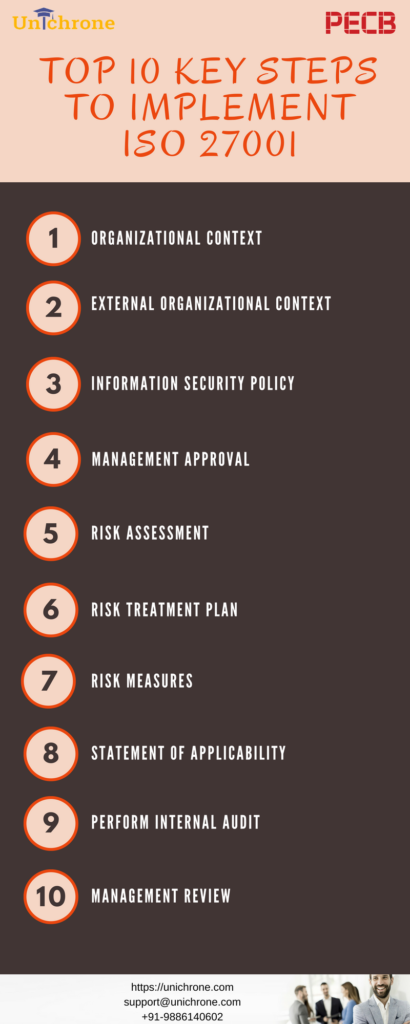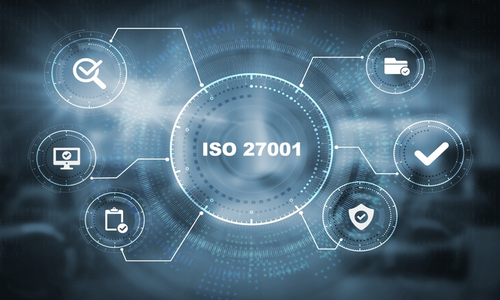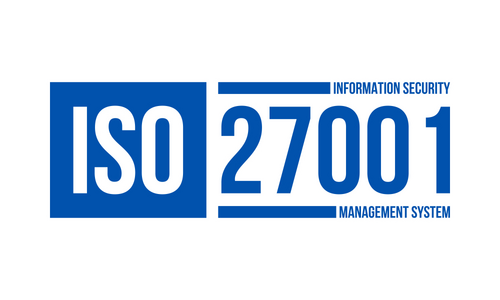
Jump ahead to
Implementing ISMS in 10 Steps
The following are the steps involved in implementing Information Security Management System (ISMS).
-
Organizational Context:
So, a lot of people talk about implementing an ISMS and often think that’s an extremely complex thing to do, but actually there are a number of key steps which will allow you to very quickly to get your ISMS of the ground, within a 10 day period. Then, following on from that you really need to then to embed that in the organization – the organizations culture. The first step to success really is to understand what we call a context of your organization and that simply about taking some time to understand the kind of products and services you offer to your customers and understand the kind of risks in your organization so that you can actually build your ISMS in the right path of your business and protect those processes that really do need to be controlled from a security point of view.
-
External Organizational Context:
Once you have an understanding of the internal context and those important business processes an assets and so forth, you then need to take a look at what’s going on outside of your organization; what kind of legislation applies to your business from a security point of view, what sort of threats and risks do you face from the outside. So if you got intellectual property, would your competitors be interested in that intellectual property, would cyber criminals be interested in that kind of data you have, so you get a very good understanding and from there you can set up about writing your ISMS scope. An ISMS scope is absolutely critical. If you start with a fairly small scope you can then implement an ISMS quite quickly and then over time your strategy could be to grow the ISMS from there.
-
Information Security Policy:
Once you have understood the scope and exactly where in your organization you’d ’like to start implementing your ISMS, the next thing really is to ensure that your management fully understand your strategy, then the benefits behind this, and there are a number of things that we can do and of way of showing that management commitment is putting together a clear information security policy and in that policy, that’s where you’re going to state what your ISMS is trying to achieve, .i.e. the objectives and indeed, you should have a number of objectives that are both focused on Security but also in the commercial benefits that your ISMS can bring.
-
Management Approval:
After preparing Information Security policy, the next task is to convince management and other institutions. One of the best ways to convince management here is to implementing proactive processes that can significantly reduce your costs. Reduction in costs can be done when professionals have adequate understanding of the risks that may arise within the organization. These risks can also help in finding opportunities for increased efficiency, cost savings, robust strategies for dodging potential security breaches. The only setback is that only few organizations are certified with ISO 27001. The present advent of technology has necessitated employees as well as customers to take Cybersecurity seriously, thereby compelling organizations to comply with ISO 27001 Standard. Seeking management approval allows stakeholders of the organization to know that approval for information security policy has come from the top.
-
Risk Assessment:
The next step in implementing ISMS is to identify the origins of risks affecting the information security. ISMS team needs to agree on the process risk assessment, and classifying based on its potential. A lot of organizations fear this process as it can very complicated while following complex risk assessment methods. The most common questions to ask include: “Where are the threats coming from?”, “Who is out there who might want to compromise our information or steal our information?”, What kind of techniques might they use? and so forth. There are usually a number of contenders whether it be insider fraud risks, text from cyber-criminal groups, competitors and so on. Even a simple brainstorming session can assist in identifying those potential sources of risk. Once the sources are identified, solutions can be drawn for mitigating risk sources using advanced methods. Having a proper risk management procedure makes it even more easier for ISMS team to protect information assets.
-
Risk Treatment Plan:
As discussed earlier, on identifying and assessing potential risks, a risk treatment plan needs to be prepared by the ISMS team. In simple words, a risk treatment plan lays out recommendations that can be used to treat potential risks. These solutions involve vigorous processes that can significantly reduce the occurrence of high-level risks affecting information security. The solutions can further consider the budget and resources available at the disposal of organization for treating risks.
-
Risk Measures:
The annex of ISO 27001 Standard specifies the information security controls that an organization can apply. ISMS team can implement each and every one of them in order to implement the information security management system. Certified professionals can have a look at these controls and choose the best and relavant controls as per the needs of the organization.
-
Statement of Applicability:
The Statement of Applicability simply says: “Which of those controls you are implementing and why?” and “Which controls you’ve chosen not to implement?” Choosing not to implement the controls needs organizations to state the reasons. Choosing the security control is based on the risks that have to be managed, legal requirements for applying the control, regulatory reasons, and contractual obligations. A lot of organizations probably implemented many of the controls from the ISO 27001 already. You might call those your best line controls as well so it’s also worth looking at what you already have in place.
-
Perform Internal Audit:
On applying the necessary security controls, the next phase is to design the internal audit process. an internal audit is the process that involves independent audit of the information security management system. Conducting such audits assists in looking into certain parts of ISMS easily. the most important factor of internal audit is that it has be done by people who work independently within the organization. In addition, professionals responsible for conducting such audits need to have adequate experience and certification such as ISO 27001 Lead Auditor. Thereafter, these professionals can prepare their audit team and an audit plan for finding gaps within the ISMS.
-
Management Review:
On completing the process of identifying risks, implementing controls, performing internal audit, the final step really is to then work with senior management to understand whether the ISMS objectives are being achieved. The team can then analyze the deviations from the information security strategies and take necessary action. There is a lot of work from here to do in terms of embedding these processes, raising awareness, getting people in your organization familiar with what their role is. The roles need to be further defined from a security point of view and having a long-term strategy to achieve your objectives.
But the 10 steps we’ve just talked about are a great way of starting the project and getting something together in your organization.
Conclusion
An information security management system must adhere to the internationally renowned standard ISO 27001. ISO 27001 standard protects businesses’ resources and the data of their customers. Implementing the ISO 27001 Standard helps businesses to showcase to their current and future clients and customers that they have created an ISMS that is capable of protecting customer data. Although obtaining ISO 27001 Certification requires considerable commitment and effort, the benefits are worthwhile. Professionals interested in learning more about ISO 27001 should enroll in the ISO 27001 Lead Implementer Training Course. Trainees acquire the competency to comprehend the standard’s requirements and apply ISMS in accordance with organizational requirements.



